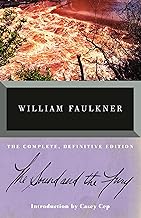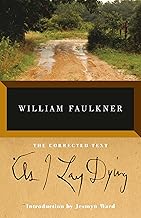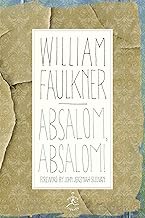
How to Read William Faulkner's Books on Reading order
How to Read William Faulkner's Books on Reading Order
Estimated Reading Time: 10-12 minutes
Introduction
William Faulkner, a towering figure in American literature, is celebrated for his intricate narratives and profound explorations of the human condition. Born in 1897 in New Albany, Mississippi, Faulkner's Southern roots profoundly influenced his writing, leading him to craft stories steeped in the complexities of race, identity, and the passage of time. His works often reflect the tumultuous history of the American South, making them not only literary masterpieces but also vital cultural commentaries.
Faulkner's unique narrative techniques—such as stream of consciousness and multiple perspectives—challenge readers to engage deeply with the text. This guide aims to provide a reading order for three of his seminal works: The Sound and the Fury, As I Lay Dying, and Absalom, Absalom!. Each book offers distinct insights into the theme of reading order, making them essential for anyone looking to understand Faulkner's literary landscape.
Why William Faulkner's Perspective Matters
Faulkner's approach to narrative structure and time is particularly noteworthy. Unlike many authors who adhere to linear storytelling, Faulkner's works often unfold in non-linear ways, reflecting the fragmented nature of memory and experience. This distinctive style not only enriches the reading experience but also invites readers to grapple with the complexities of human perception.
His exploration of Southern identity and the legacy of the Civil War provides a critical lens through which to examine contemporary issues of race and social justice. Faulkner's insights into the human psyche and societal constructs remain relevant today, making his works a treasure trove for both literary enthusiasts and those seeking deeper understanding of human behavior.
Overview of Recommended Books
The Sound and the Fury
The Sound and the Fury (1929) is perhaps Faulkner's most famous work, renowned for its innovative narrative techniques and emotional depth. The novel is divided into four sections, each told from the perspective of different characters, primarily focusing on the decline of the Compson family, a once-aristocratic Southern family.
Main Themes and Arguments
The novel tackles themes of time, memory, and the disintegration of social order. The first section, narrated by Benjy Compson, a cognitively disabled man, presents a fragmented view of time that challenges conventional narrative structure. The second section, narrated by Quentin Compson, delves into themes of honor and familial duty, while the third section, told from the perspective of Jason Compson, highlights themes of resentment and materialism. The final section, narrated in the third person, reveals the family's tragic fate.
Historical Context and Significance
Set against the backdrop of the post-Civil War South, the novel reflects the cultural and social upheavals of the time. Faulkner's portrayal of the Compson family's decline symbolizes the broader decay of Southern aristocracy and traditional values.
Key Insights and Takeaways
- The Nature of Time: Faulkner challenges readers to reconsider the linearity of time, suggesting that past, present, and future are intertwined.
- The Complexity of Identity: Each character's perspective reveals the multifaceted nature of identity and the impact of societal expectations.
- The Burden of Memory: The novel emphasizes how memory shapes our understanding of ourselves and our relationships with others.
Why Read This Book: The Sound and the Fury is essential for understanding Faulkner's exploration of time and identity. Readers interested in psychological depth and narrative innovation will find this work particularly rewarding.
As I Lay Dying
Published in 1930, As I Lay Dying follows the Bundren family as they embark on a journey to fulfill the dying wish of their matriarch, Addie Bundren, to be buried in her hometown of Jefferson, Mississippi. The novel is notable for its use of multiple narrators, each providing a unique perspective on the family's struggles.
Main Themes and Arguments
The novel explores themes of death, family dynamics, and the search for meaning in suffering. Each character's voice reveals their personal motivations and conflicts, creating a rich tapestry of human experience.
Historical Context and Significance
Set in the rural South during the early 20th century, the novel captures the hardships faced by families during this period, including poverty and social isolation. Faulkner's portrayal of the Bundrens reflects the resilience and fragility of human relationships.
Key Insights and Takeaways
- The Nature of Suffering: The characters' journeys illustrate how suffering can unite or divide individuals.
- The Quest for Identity: Each narrator grapples with their sense of self in relation to family and societal expectations.
- The Role of Language: Faulkner's innovative use of dialect and voice emphasizes the power of language to convey emotion and experience.
Why Read This Book: As I Lay Dying is crucial for understanding Faulkner's exploration of existential themes and the complexity of human relationships. Readers seeking a profound examination of family dynamics and the human condition will find this work compelling.
Absalom, Absalom!
Published in 1936, Absalom, Absalom! is a dense and challenging novel that delves into the life of Thomas Sutpen, a plantation owner who seeks to create his own dynasty in the antebellum South. The narrative unfolds through multiple perspectives, revealing the complexities of Sutpen's character and the impact of his actions on those around him.
Main Themes and Arguments
The novel addresses themes of ambition, race, and the legacy of the past. Sutpen's relentless pursuit of success leads to tragedy, highlighting the moral ambiguities of his character and the societal structures that shape his fate.
Historical Context and Significance
Set during and after the Civil War, the novel reflects the deep-seated racial tensions and social hierarchies of the South. Faulkner's portrayal of Sutpen's rise and fall serves as a critique of the American Dream and its implications for identity and morality.
Key Insights and Takeaways
- The Complexity of History: Faulkner emphasizes that history is not a singular narrative but a tapestry of conflicting perspectives.
- The Burden of Legacy: The characters grapple with the weight of their familial and societal legacies, questioning the morality of their ancestors.
- The Nature of Truth: The novel challenges readers to consider the subjective nature of truth and the impact of storytelling on our understanding of the past.
Why Read This Book: Absalom, Absalom! is essential for those seeking a deeper understanding of Faulkner's exploration of history and identity. Readers interested in complex narratives and moral ambiguity will find this work particularly enriching.
How These Books Complement Each Other
While each of Faulkner's novels stands on its own, they collectively offer a comprehensive exploration of themes related to time, identity, and the human experience. The Sound and the Fury introduces readers to Faulkner's innovative narrative techniques, while As I Lay Dying deepens the exploration of family dynamics and existential questions. Absalom, Absalom! expands on these themes by examining the complexities of history and legacy.
Reading these works together allows for a richer understanding of Faulkner's literary contributions and the multifaceted nature of the human condition.
Who Would Benefit from Reading These Books
- Students and Academics: Those studying literature, particularly American Southern literature, will find Faulkner's works invaluable for understanding narrative structure and thematic depth.
- General Readers: Anyone interested in profound explorations of identity, family, and history will appreciate the emotional and intellectual richness of these novels.
- Professionals Seeking Practical Wisdom: Readers looking for insights into human behavior and societal dynamics will find relevant lessons in Faulkner's characters and their struggles.
- Personal Growth Seekers: Individuals interested in self-improvement and understanding the complexities of human relationships will benefit from Faulkner's explorations of the human psyche.
Recommended Reading Order
- Start with: The Sound and the Fury - This novel introduces Faulkner's unique narrative style and thematic concerns, making it an essential starting point.
- Continue with: As I Lay Dying - Building on the themes of identity and family, this book offers a more intimate exploration of human relationships and existential questions.
- Advanced reading: Absalom, Absalom! - This complex narrative challenges readers to engage with the intricacies of history and morality, providing a deeper understanding of Faulkner's literary vision.
Tips for Getting the Most Out of Each Book
- Take your time with the narratives, allowing the language and structure to unfold naturally.
- Consider keeping a journal to reflect on your thoughts and insights as you read.
- Engage with secondary sources, such as literary analyses or discussions, to enhance your understanding of the themes and context.
Conclusion
William Faulkner's contributions to literature offer profound insights into the complexities of human experience, particularly through the lens of time, identity, and societal constructs. His works remain timeless, resonating with contemporary readers and providing a rich tapestry of themes to explore.
As you embark on this literary journey, allow Faulkner's narratives to challenge your perceptions and deepen your understanding of the human condition. Dive into these works and discover the enduring relevance of Faulkner's exploration of reading order, identity, and the intricacies of life.
Tags: #William Faulkner #Reading order #Philosophy #ReadingGuide #ClassicLiterature #Wisdom
Featured Books

The Sound and the Fury
by William Faulkner
Published: 1929
NOBEL PRIZE WINNER • One of the greatest novels of the twentieth century is the story of a family of Southern aristocrats on the brink of personal and financial ruin. • The definitive corrected text, including Faulkner's AppendixOne of The Atlantic’s Great American Novels of the Past 100 YearsThe Sound and the Fury is the tragedy of the Compson family, featuring some of the most memorable characters in literature: beautiful, rebellious Caddy; the manchild Benjy; haunted, neurotic Quentin; Jason, the brutal cynic; and Dilsey, their black servant. Their lives fragmented and harrowed by history and legacy, the character’s voices and actions mesh to create what is arguably Faulkner’s masterpiece and one of the greatest novels of the twentieth century.“I give you the mausoleum of all hope and desire.... I give it to you not that you may remember time, but that you might forget it now and then for a moment and not spend all of your breath trying to conquer it. Because no battle is ever won he said. They are not even fought. The field only reveals to man his own folly and despair, and victory is an illusion of philosophers and fools.” —from The Sound and the Fury Read more

As I Lay Dying
by William Faulkner
Published: 1930
A true 20th-century classic from the Nobel Prize-winning author of The Sound and the Fury: the famed harrowing account of the Bundren family’s odyssey across the Mississippi countryside to bury Addie, their wife and mother. As I Lay Dying is one of the most influential novels in American fiction in structure, style, and drama. Narrated in turn by each of the family members, including Addie herself as well as others, the novel ranges in mood from dark comedy to the deepest pathos. “I set out deliberately to write a tour-de-force. Before I ever put pen to paper and set down the first word I knew what the last word would be and almost where the last period would fall.” —William Faulkner on As I Lay Dying This edition reproduces the corrected text of As I Lay Dying as established in 1985 by Noel Polk. Read more

Absalom, Absalom!
by William Faulkner
Published: 1936
This postbellum Greek tragedy is the perfect introduction to Faulkner’s elaborate descriptive syntax.Quentin Compson and Shreve, his Harvard roommate, are obsessed with the tragic rise and fall of Thomas Sutpen. As a poor white boy, Sutpen was turned away from a plantation owner''s mansion by a black butler. From then on, he was determined to force his way into the upper echelons of Southern society. His relentless will ensures his ambitions are soon realised; land, marriage, children, his own troop to fight in the Civil War... but Sutpen returns from the conflict to find his estate in ruins and his family collapsing. Secrets from his own past threaten to ruin the lives of his children and destroy everything he has worked for. Read more